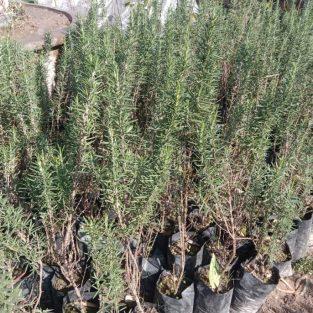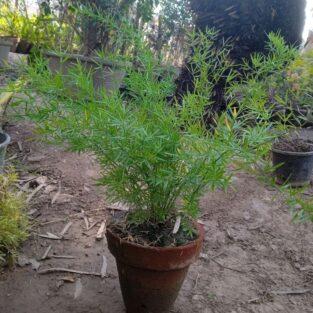Rosemary Plant | Buy rosemary online
₨600.00
Add to cart
Buy Now
Growing Rosemary
The Mediterranean herb rosemary plant needs to be watched for the soil and water condition. When it is in the warmest regions the plant can grow into a massive evergreen tree.
The rosemary plant is a hardy plant with needle-like leaves which can typically be 3 feet high and eventually reach 5 feet in more temperate environments if cut. If you live in zone 8 or further to the south, rosemary plants make an excellent evergreen hedge. For zone 7 and cooler it is possible to plant rosemary in containers that which you can take inside during the cold winter months. It is possible to train rosemary to form topiary forms. They are resistant to salty air, which makes an ideal option for pots to be placed on the sandy beach.
Quick Guide to Growing Rosemary plant
- The best time to plant rosemary plant is in the spring after all chance of frost has been averted. This delicious herb can be a star for the kitchen, and it is an excellent choice for garden beds that are raised or containers as well as ground-based gardens.
- Place rosemary plants about 2 or 3 feet apart within an area of abundant sunshine as well as a rich, well-drained soil that has a pH range of 6.0 up to 7.0.
- Before you plant, make sure to prepare your garden for a successful start by mixing several inches of compost that has been aged or another organic matter rich in nutrients to your existing soil. To grow your garden in containers, you should consider an excellent bagged mix for potting.
- You can encourage a dramatic growth rate by feeding the rosemary on a regular basis by feeding it a plant food that is water-soluble.
- It’s essential to water frequently however, be sure to allow the soil to dry between each watering.
- Cut rosemary leaves by snipping the stems with sharp garden shears. Pick them often after the plant is established be careful not to cut more than one third of the plant at one moment.
Soil, Planting, and Care of rosemary plant
In spring, plant rosemary by planting the starter plants between 2 and 3 feet You can also plant the plants in autumn in zones 8. as well as south. Select vigorous, strong Bonnie Plants(r) rosemary for your garden to get on the right foot. After all Bonnie has been around for more than 100 years helping gardeners at home to grow food for themselves. They grow slowly at first, but start to pick up pace in the second year.
Rosemary is a fan of full sun as well as an aeration that is light and well-drained that has a pH range of 6-7. Enhance your soil’s condition by adding just a few inches of old compost-enriched Miracle-Gro(r) The Performance Organics(r) All Purpose in-Ground Soil and blending it to the soil layer on top. The potted rosemary requires a lighter weight soil mix. Fill the containers using Miracle-Gro(r) The Performance Organics(r) All Use Container Mix instead. Maintain the soil evenly damp, and allow it to dry between the waterings. Cover your plants with mulch to keep the plants hydrated in summer, and kept warm in winter. But be sure to keep the mulch off the top that the plants are growing on. When spring arrives, trim dead wood from the plant.
To ensure the best possible growth for your plants, it’s important to begin with a healthy, well-nourished soil. Also, you should provide rosemary with regular feeding all throughout the season. You can do this by feeding it an herb food that nourishes your plants as well as the soil. This is something like Miracle-Gro(r) Perform Organics(r) Food for Plants (following the directions printed on the packaging).
Troubleshooting
Whiteflies and spider mites as well as mealybugs, and scale can be a nuisance to rosemary along with the root rot and powdery mildew especially in areas with humid conditions. To stop the growth of mildew or decay, make sure that the plants are able to drain and air movement. If you live in zone 7 or northwards, extreme cold can cause the tops to die of the rosemary plants. If you live in areas that are susceptible to being damaged by winter storms, it is best to plant it in an area that is protected, for example, near an masonry wall facing south and out of the direction of the predominant winter breeze; you can also mulch the area to guard against root damage. If you live in zone 8 or further to the south, rosemary doesn’t require winter protection.
Harvest and Storage
The stems can be cut at any time to make fresh rosemary. To dry rosemary, hang it on racks or hang it upside-down in groups for drying. When the stems are dry remove the leaves from the stems. It is also possible to keep rosemary sprigs in a freezer, preserve them in vinegar or even use the rosemary sprigs to flavor oils and butter.
Uses
Although rosemary plant is a great blend with other herbs, try the herb as a stand-alone herb in pork, lamb or chicken dishes. It can also be used in stews and soups, vegetables and sauces. Rosemary is a great flavor in breads, and can make an excellent marinade using wine, olive oil and garlic. Its aromatic qualities can be a great addition to a flower arrangement, bath wreath or even a sachet.
FAQs
Does rosemary mix well with other plants in my garden?
As opposed to other herbs that only live in a single season it is an evergreen plant that thrives in zones 8 and further south. That’s why it is important to select a spot that will allow it to develop for the decades to come. It flourishes in a sun-drenched place that is well-drained. It can grow three feet high and broad. It can be placed near the entrance to your garden and to make it part of your home’s landscaping. Since it smells so delicious after being touched, it’s an ideal addition to the porch or sidewalk.
What’s the temperature tolerance of rosemary plant?
It is a perennially hardy plant within USDA zones 8 through further south, which is in regions where temperatures do not drop below 10 or 15 degrees. If you are within zone 7 you should plant in a secure location, for example, close to a wall facing south for extra warm nights.
Do I have to trim rosemary at any time or is there a specific time to trim it?
Just like any other herb for cooking that you can use, it is important to trim fresh, delicious foliage at any time you require it. The plants will benefit from a regular pruning schedule from early spring through the middle of summer. Avoid cutting into branches that are darker and woody. These will not be able to produce new growth than those with young wood. Keep in mind that rosemary won’t be perfectly round due to its nature to have stems that are upright. The overall shape of the plant could become more dense with pruning in order to promote branches.
I planted rosemary in a large container and let it grow out for the winter. Do I need to cut it down or wait for the fresh development?
Springtime before it begins to grow is a great time to trim all evergreens, and this includes rosemary. Take away any dead or green stems first. Then, after that, you can trim them to enhance the appearance of the plant. Do not cut any stems that appear extremely old as they might not produce new shoots as easily in the same way as stems that are younger. If your rosemary plants is well-shaped and you’re happy with it to grow larger and taller, keep in mind that pruning is not necessary. When rosemary is planted in a pot, make sure you do not allow it to dry out enough to cause it to wilt. It could not reseed.

























Reviews
There are no reviews yet.